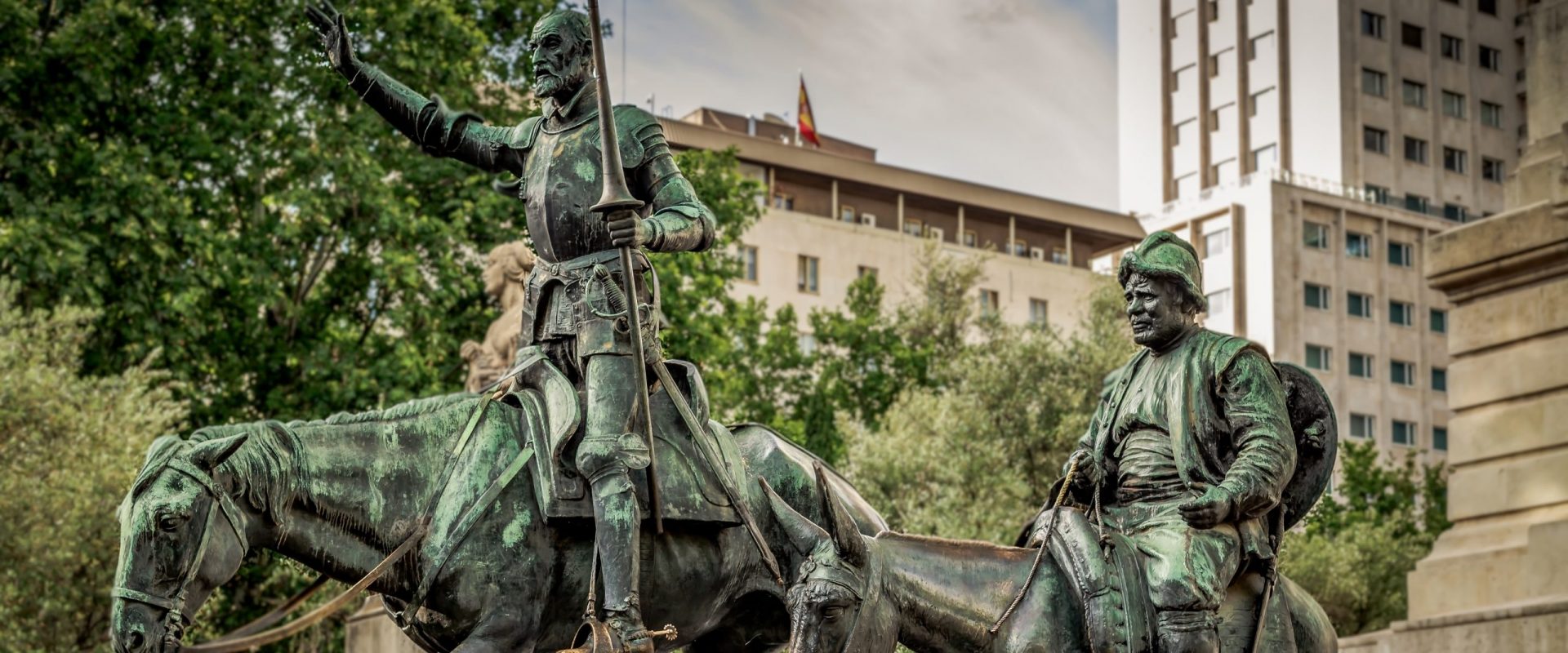Quixote and Panza – a double figure with access to the world
Contents
Quixote and Panza – a double figure with access to the world
Georg Lukács (1916, 395) gives us insight into the time in which Cervantes created the work. This first great novel of world literature stands »at the beginning of the time when the God of Christianity begins to leave the world; when man becomes lonely and is only able to find meaning and substance in his soul, which has no home anywhere; when the world is let go of its paradoxical anchoring in the present beyond, abandoned to its immanent meaninglessness. … It is the period … of the great confusion of values with the value system still in existence. And Cervantes … has captured the deepest essence of this demonic problem: that the purest heroism must become grotesque, the firmest faith madness, when the paths to its transcendental home have become impassable; that the most genuine and heroic, subjective evidence must correspond to no reality. It is the deep melancholy of the historical course, of the passing of time, which speaks of the fact that eternal contents and eternal attitudes lose their meaning when their time is over; that time can pass over an eternal. It is the first great struggle of inwardness against the prosaic baseness of outer life, and the only struggle in which it has succeeded not only in emerging unsullied from the fight, but even in surrounding its victorious opponent with the splendour of its victorious, though admittedly self‐deprecating, poetry.«
Frerichs (2016) emphasises at this point the parallelism with Shakespeare’s Hamlet in terms of contemporary history and – in our view, however, only in part – content: »The heroes of Shakespeare’s dramas fulfil a destiny evoked by the contradictions of their time. Hamlet in particular, a reflective melancholic, senses that an eternally believed order has broken down and lost all meaning. While man finds security and confirmation within the framework of firmly established systems of order, he now experiences a state of dissolution and emptying of meaning. Hamlet, who is extremely sensitive to these developments, loses touch with reality and gradually falls into a life‐threatening isolation from which no way back seems possible. In this state, the firmest belief becomes madness, since subjective perception no longer corresponds to objective reality.«
Hamlet represents the brooding, melancholic, contradictory nature of the awakening subject of modernity. He lives, only seemingly similar to Quixote, isolated in his own world. Hamlet is tired of the world; »it is to him a desolate garden, … everything is disgusting, stale, flat and unenjoyable. Hamlet is no longer capable of any action, not because he lacks courage, but because he considers all action senseless. His distance from the world around him has become too great. He cannot bridge it even through some kind of higher consciousness; every way out seems closed to him.« (ibid.).
Unlike Hamlet, Quixote does not lack an alter ego who is his counterpart in the world and who saves him from despair! Hamlet, unlike Quixote, in the flight of his attachment finally falls into deepest despair, into depression and catatonia.
As far as we know, it was Heinrich Heine (1976, 165) who first pointed out that with Quixote and Panza, Cervantes created a double figure that enables him to portray both characters in their interaction in a common world and thus emphasises and develops the dialogical principle mentioned at the beginning, in which their multifacetedness is revealed from their very different ways of being and moods and can thus escape the narrowing of solipsistic self‐indulgence:
»As for those two characters who call themselves Don Quixote and Sancho Panza, who constantly parody each other and yet complement each other so wonderfully that they form the [sic!] actual hero of the novel, they testify to the same extent to the poet’s sense of art as to his depth of spirit. Whereas other writers, in whose novels the hero moves through the world as a single person, … Cervantes is able to make a natural dialogue appear everywhere; and as one character always parodies the speech of the other, the poet’s intention emerges all the more visibly. … neither in the masterpieces of other artists nor in nature itself do we find the aforementioned two types so precisely executed in their interrelationship as in Cervantes. Every trait in the character and appearance of the one corresponds here to an opposite and yet related trait in the other.«
So, while Quixote stretches out designs of freedom and human dignity to society, Panza is widely seen as a typical representative of the reality principle, conformity and opportunism of that very society. He belongs to those »who believe only what they can touch or taste. Who is always concerned with his own advantage and weighs everything according to whether something will benefit or harm him. A precursor of homo economicus; paired with a portion of fatalism. Thus, the figure of Sancho Pansas not only embodies clumsy folksiness, but at the same time stands for a new type of society that owes itself to so‐called common sense and an astonishing portion of calculating shrewdness.« (Frerichs, 2016).

